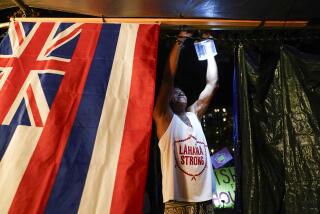New Hawaii Services Look to Make Waves
- Share via
HONOLULU — Every other month, Jovina Neal takes a 170-mile flight from Oahu to the Big Island to visit family. Her husband, Travis, often stays home because they can’t afford another $200 round-trip ticket.
“It’s ridiculous, but there’s not much we can do but pay,” she said last week as she waited to catch an Aloha Airlines flight from Honolulu to Kona.
Hilo businessman John Schulte takes a 45-minute flight to Honolulu every week. His most recent round-trip ticket on Hawaiian Airlines cost $300.
“What can you do?” he asked. “This is our interstate highway.”
Interisland travel has long been difficult and expensive in Hawaii, which has no underwater tunnels, no interisland bridges and no regular ferry service.
But the state’s local travel industry is likely to undergo a transformation when a low-cost airline and an interisland ferry enter a market dominated for decades by Hawaiian Holdings Inc.’s Hawaiian Airlines and Aloha Air Group Inc.’s Aloha Airlines.
“It’s just a very dynamic time in Hawaii,” said airline industry analyst Bob Mann of New York-based R.W. Mann & Co. “Arguably, it’s the best time for consumers because they’re going to get the benefit from carriers who very much need to generate cash flows and maintain market share.”
FlyHawaii Inc. and Hawaii Superferry Inc. say they’ll reconnect the state and make it easier and much cheaper to hop around the islands.
“In many ways, we’re trying to lasso these islands and pull them together,” FlyHawaii Airlines Chief Executive James Delano said.
The airline announced plans this month to launch service in early 2006, and aims to keep costs down with a fleet of ATR-72 turboprops, which can carry 68 passengers. The company is marketing itself as a commuter airline that offers fewer restrictions and one-way fares as low as $50.
Hawaii Superferry plans to operate two giant catamarans carrying 900 passengers and 250 vehicles between Oahu and Maui, Kauai and the Big Island. The first ferry is scheduled to begin operating in early 2007. Although public support has been strong for Superferry, the company still faces several hurdles: building costly infrastructure at the ports and a lawsuit filed last week by environmentalists, seeking a detailed environmental impact study.
Hawaiian and Aloha, whose parent companies are in bankruptcy protection, dismiss the new competitors and note that others have tried to enter the interisland travel market with little success.
Discovery Airways began flying in 1990 and folded the following year. Mahalo Airlines flew from September 1993 until October 1997 but went broke. Seaflite launched a hydrofoil system in 1975 and ceased operations three years later.
“It’s a very difficult business, particularly because of the brutal, competitive response by the incumbent carriers,” Mann said.
Seaflite’s three jet-engine vessels had difficulty in the open ocean’s huge swells and with floating objects like logs that damaged their foils. Seaflite ceased operations when other ventures by its parent company failed.
Discovery and Mahalo could not generate enough passengers and were eventually squeezed out of the market by Hawaiian and Aloha.
“We’ve seen other interisland carriers come and go, leaving their customers holding worthless tickets,” Aloha spokesman Stu Glauberman said.
Mark Dunkerley, Hawaiian’s president and chief executive, said his company “welcomes competition as another opportunity” to show travelers the benefits of his company.
Delano expects the skepticism.
“They think we’re a joke, and that’s fine,” he said. “Perhaps they shouldn’t be concerned because we may be in a market for additional customers, not taking customers away from them.”
Many travelers say they’ll choose whatever route is most affordable.
“I bought a ticket to Kona for $200 and last year I flew to Kentucky for $400,” said Travis Neal, a Marine who lives in Kailua. “It’s almost cheaper flying to the mainland than to the Big Island.”
Maui resident Jose Carrizosa said it cost a fortune to take his wife and two children on the 25-minute flight from Maui to Honolulu. If fares were lower, Carrizosa said, he would travel more often to see friends, go shopping or even fill up on gasoline on Oahu, where a gallon of unleaded is typically cheaper.
FlyHawaii’s Delano said there was a lot of “pent-up demand” for interisland travel. He noted that travel between islands has declined despite a tourism boom.
“The overwhelming reason for that is lack of frequency and lack of access to lower fares,” he said. “I think if we bring that back, the market will go up.”
Hawaii Superferry -- which bills itself as “H-4” after Oahu’s H-1, H-2 and H-3 freeways -- is also targeting the local market.
“No matter how we price against somebody else, we’re a tremendous value,” CEO John Garibaldi said.
Garibaldi, a former finance executive for both Aloha and Hawaiian, said there had been a 20% drop in Hawaii residents taking interisland flights in the last five years.
Mann expects the jet carriers to respond with a fare war, but believes that FlyHawaii could survive, just as low-cost Southwest Airlines has in other cities.
“What generally happens is, the number of people traveling doubles, triples or more because of the unrestricted low fares,” he said.
However, only a handful of start-up carriers survive.
More to Read
Sign up for The Wild
We’ll help you find the best places to hike, bike and run, as well as the perfect silent spots for meditation and yoga.
You may occasionally receive promotional content from the Los Angeles Times.






